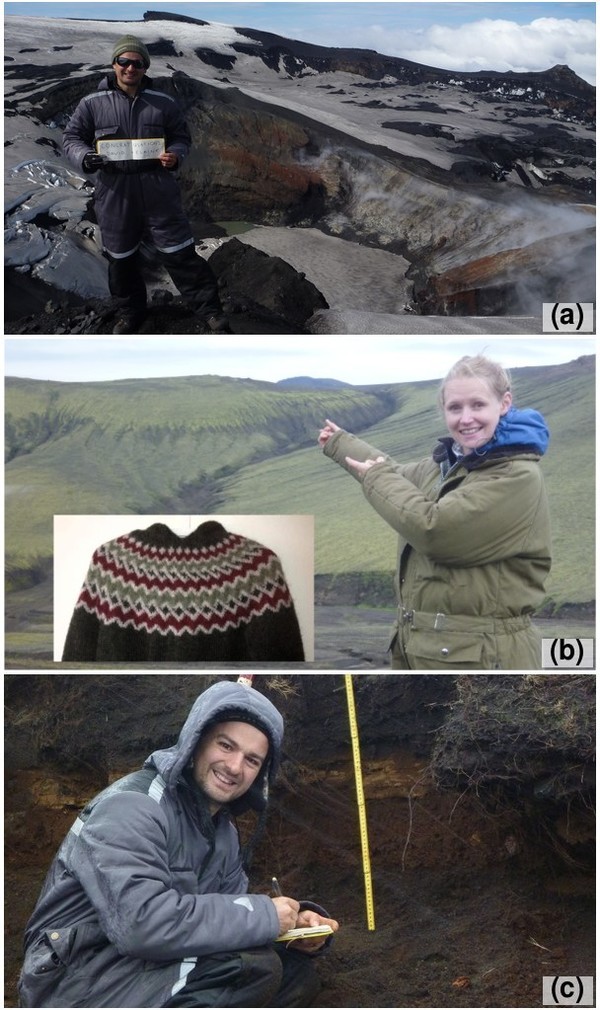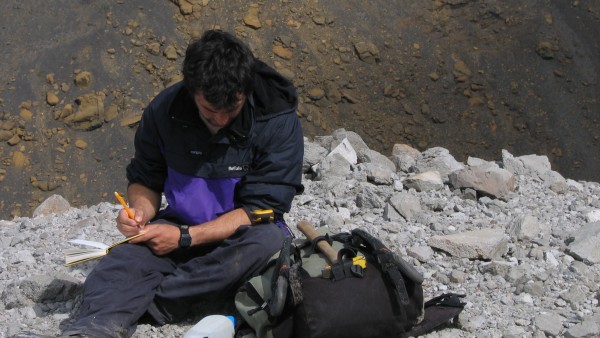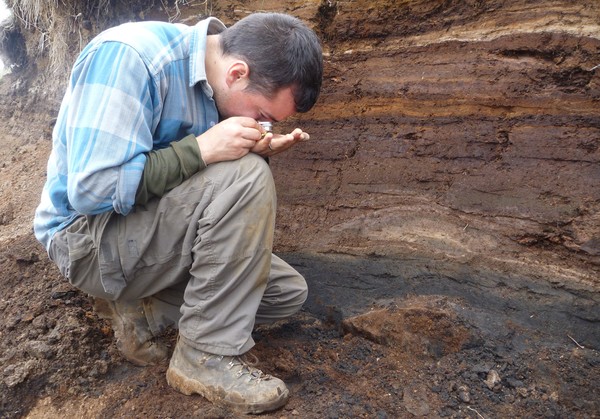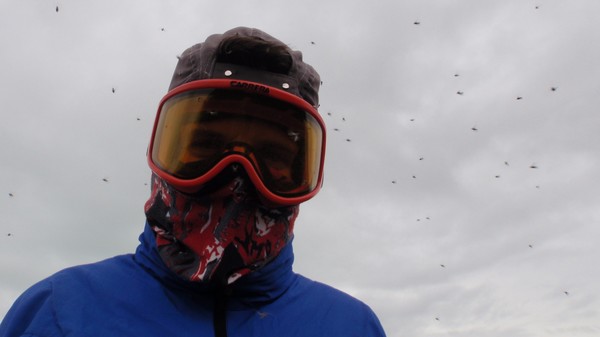I have a special volcano suit. It isn’t a silvery heatproof number for sampling red-hot lava, though. It’s a fleece-lined boiler suit. I bought it for fieldwork in Iceland and it works very well. This post describes the suit, then lists the clothing that I recommend more generally for hiking, camping or exploring the country.
Edit: 08 September 2013. I have updated this post slightly, following an early autumn Iceland trip with a tight schedule that forced us to work in some very wet and fairly cold weather. The new text is coloured blue.
Volcano Suit
The Icelandic name for these suits is kuldagalli. They are sold in hardware stores and used by people working outdoors over the winter, or when riding snowmobiles. In my current project, sampling the deposits of the Hekla 3 and Hekla 4 eruptions from a camper van, I do a lot of work within 20 minutes walk from the road. I dig a hole in the soil, then spend up to 3 hours recording ash layers and measuring pumices within it.

Volcano suits. (a) Wearing the volcano suit at the summit crater of Eyjafjallajökull (notebook says “Congratulations David and Elaine”. (b) Gemma models a kuldagalli, while the hill behind models a lopapeysa (Icelandic wool sweater). Inset: Lopapeysa knitted by Dr Morgan Jones (@drmorganjones). (c) Sampling in a light sleet shower in perfect comfort.
My suit is very warm, with thick pile insulation and a tough polycotton exterior. It has a fluffy hood, and no gaps where the wind can get in. It isn’t waterproof, but that doesn’t really matter because it is still warm when it is damp (more on this below). It is perfect for long periods sitting still and, because I never walk far, I don’t get cooked when I do move about. Best of all, when I come back to the van, covered in mud, I can just take it off and throw it in the back so I don’t mess up the interior.
A few words on Iceland’s Weather
The weather in Iceland during summer is similar to the hills of the UK in spring or autumn, and the weather in Iceland during spring or autumn is similar to the hills of the UK in winter. So this advice applies in the UK, too. Rain is common and is often light or showery, but wind is the most important factor in how you feel. If you have the flexibility, use the weather forecast (www.vedur.is) to plan your trip. The best weather is usually found on the opposite side of the island to where the wind is blowing from.
What to wear in Iceland
The following list describes what I currently wear for fieldwork in Iceland, and has evolved over 12 years of working there. There is one message that I want to get across: take waterproofs, but aim to wear them as little as possible. Instead, I recommend a ‘soft shell’, approach based on pile and Pertex. Pertex is a fabric that few outside the UK have heard of. It isn’t waterproof, but is very tough, windproof and breathable, and is much less stiff than waterproof fabrics. British climber, Andy Kirkpatrick (@psychovertical), gives a great description of the soft shell concept and how it is based on the traditional clothing of native Arctic hunters:
This single layer of skin and fur provided excellent insulation even when damp, providing the wearer’s body with enough warmth to stay alive and, in doing so, dry out the insulation from within rather than rob it of what heat it had left.
The main idea is that windproofing is most important, and that it doesn’t matter if you get wet as long as the clothing is breathable enough to take the water away from your skin. This philosophy is perfectly suited to Iceland’s climate, where you are frequently wet, but not too wet. It lets you be warm and comfortable while others ask “Aren’t you cold? Don’t you need a jacket?”
Waterproof membrane layers, even with modern fabrics such as Gore Tex, trap sweat and make you cold. They should only be worn only if you are forced to be out in heavy or persistent rain. On my recent fieldwork I decided that if it was wet enough to need Gore Tex it was too wet to take samples anyway, so I sat out the showers in the van.
Clothes for your torso
Wicking baselayer: This is probably the most important item on this list. It takes the moisture away from your skin, so sweating doesn’t chill you. Cotton t-shirts (or jeans) do not wick like this and are very slow to dry. If you are wearing a waterproof jacket, however, even these layers will get wet with sweat. Helly Hansen make the classic wicking base layer. I often wear a winter version when I’m in Iceland, which is thicker and contains Merino wool, and wear a wicking t-shirt on warmer days.
Lumberjack shirt: I like to wear shirts in the field for three reasons. Firstly, they let you fine-tune your temperature by undoing buttons and rolling up sleeves. Secondly, you can use the collar to keep the sun off your neck. Thirdly, the breast pockets are handy for a hand-lens and compass-clinometer, with the strings larks-footed through the button holes. Being made of cotton is less of an issue when it isn’t next to the skin, but if it gets really wet in the rain it will take a long time to dry so it is better to leave it behind if the weather is poor.
The soft shell jacket (or smock) lets you keep your waterproofs in your bag. When the wind starts to cool you, put this on instead. I love my Buffalo Teclite Shirt. It is, without doubt, the most versatile and useful piece of outdoor clothing that I have ever owned. As well as for fieldwork, I’ve used it climbing, mountain biking, running, cycle touring, skiing and caving. It’s been on every adventure that I’ve had in the last 8 years, from the Arctic to the Equator and from 5000 m altitude to 100 m underground.

My Buffalo Teclite Shirt made its field début at Prestahnúkur, near Langjökull, in June 2005 and has had many adventures since. Teva sandals strapped to rucksack were used for river crossings. Photo by Dave McGarvie (@subglacial).
It is so useful because it is so light (the ‘classic’ Buffalo Mountain Shirts are too hot and heavy), but by blocking the wind it still feels really warm. I wear my Buffalo over my wicking base layer and can put more insulation or waterproof layers on top if necessary. When it is cold, I use the hood; when it is hot, I use the side vents and roll up the sleeves. It also has big pockets for maps and notebooks. If it gets wet it is still warm and the best way to dry it out is just to keep wearing it. If it gets ripped, you can stitch it back up again.
Páramo, Montane and RAB (Vapour Rise) also do pile and Pertex soft shell gear. Fleeces with a wind/waterproof membrane don’t count. It requires a slight change in outlook to wear this system. You have to accept that being wet is OK, and that it isn’t the kind of thing that you would wear around town. But if you spend a lot of time outdoors, you will love how well it works.
The lopapeysa is the classic Icelandic wool sweater. These are popular for a good reason: they are very warm, even when damp. I wear mine instead of the Buffalo once I get back to the van or to civilisation. You can wear it over the top of a soft shell if it gets really cold. Treat it like a belay jacket that you can wear indoors.
During prolonged, heavy rain, the pile and Pertex system cannot shift the moisture as quickly as it is coming at you. For this reason, you still need to carry a waterproof jacket for when it gets really wet and you have no choice to be outside, for example when hiking between camps. It is also necessary in light rain if you aren’t moving much e.g. when making measurements or cooking outside your tent. It seems that this “beyond Buffalo” rainfall corresponds to around 3-6mm/3hrs (green on the Iceland Met Office rainfall maps) and may be less if the wind is strong. If the outer layer saturates and the rain is still falling it is time to put on waterproof outer shell layers.
I just invested in a Mountain Hardware Morpheus. It is an outer shell and little more. I chose it because it should be useful for work (big front pocket for maps/notebook) and play (pockets accessible with a harness on and hood goes over a helmet). In the second-most recent 14 days in Iceland, I only wore it twice. In the most recent 8 days in the field, it was needed on 6. Keeping it in my bag stopped me sweating and stopped it getting ruined on the lava and the scree and the ash.
Clothes for your legs
Lined hiking trousers: Craghoppers hiking trousers are good for fieldwork because they have good notebook/map pockets. The winter ones have a tightly-woven polycotton outer, but are lined with fleece so they act in a similar way to pile and Pertex. They are excellent, because you never feel the cold against your legs, even if the outside is damp. This way you don’t need waterproof trousers unless the rain is pouring down.

Leather boots. Fleece-lined trousers. Wicking baselayer. Shirt. Hand lens. David Attenborough wears the same clothes every day because it helps with continuity when shooting TV programs. I wear the same clothes every day because they work really well, and because it is one less thing to think about.
You can get a similar effect by wearing wicking baselayer leggings under normal hiking trousers. Some friends in Iceland use tough polycotton builders’ trousers from a hardware store as an outer layer – they even have a loop for a geological hammer. Technical alpine-style trousers, e.g. those made of Schoeller-type material (black, stretchy stuff that feels a bit like a neoprene wetsuit), are good for walking but don’t have the pockets for fieldwork.
If you get a soaking in the rain, cotton boxer shorts will stay wet and cold long after your other layers have dried. Silk or wicking underwear is better.
With these options, you should only need waterproof trousers if it is really wet. I have an old Karrimor pair. Their best feature is full-length zips that let you vent easily when you inevitably start sweat. But if your legs are warm enough, you never need to wear them.
Footwear
Leather hiking boots: I have Altberg Mallerstangs. They are ideal because they have a one-piece leather upper with minimal seams and stitching, which would get shredded by lava and scree. They also have a waterproof Sympatex lining (good for long hikes in slushy snow) and a B2 crampon fitting (good for glaciers and easy winter climbing). Canvas boots will be destroyed and technical mountaineering boots are too clumsy.
Sandals: These are vital for wading across rivers, but are also useful to have in the car. Driving between sites, you can put your boots in the boot (trunk) and give your feet some air. Ignore any comments from idiot fashionistas. There is only one good reason not to wear socks and sandals: wet grass. A straightforward pair of Tevas is ideal.
Gloves
I usually have 2-3 pairs of gloves: a thin pair of liner gloves (or fingerless woolen ones) that I can still write in; thin leather gardening gloves (a bit like golf gloves) for serious digging; and thick mittens for when it is really cold (Buffalo and Montane make pile and Pertex ones).
Headwear

Geography teacher friend Al Monteith (@al_monteith) wears all his headwear at once, against an onslaught of “Orifice Flies”. You can read about the 3 weeks we spent in the field last summer on his blog. Note the soft shell jacket.
The following items are all useful:
- Mosquito net. The flies in Iceland don’t bite, but they can swarm in huge numbers and love to crawl into your mouth, your nose, your ears and your eyes.
- Sunglasses / goggles. When the wind picks up, it brings the ash and sand with it, so these are really useful to protect your eyes. At least it also blows the flies away.
- Buff / bandana. These can be worn in many ways, such as neck warmers, ear warmers, or as a lightweight hat. Get a dark one, so that you can use it as a blindfold if daylight stops you sleeping at night.
- Woolly hat. Keeps your head warm. You can use this to fine-tune your temperature, putting it on and taking it off frequently as necessary.
Notes
All this gear is expensive and I don’t suggest going out and it all at once, especially just for a single holiday or a school trip. Start with a good wicking baselayer (remember: not cotton). If you currently own nothing else like it, it will make a huge difference to your comfort. Remember that all these items are also useful in the mountains of the UK, or any other cold, windy places.
I have made this list based on my experience and on conversations with friends. I have no affiliation with any of the brands or websites mentioned above. That said, if anyone wants to send me free kit, I wouldn’t complain…
If you strongly agree or disagree with what I’ve said, I’d be keen to hear from you. Please leave a comment below.


Good video here of someone testing buffalo clothing by submersion in a welsh mountain lake… http://www.ukactiveoutdoors.co.uk/buffalo-systems-water-test.
Owner of needle sports wrote a great piece on the merits of buffalo: http://www.needlesports.com/catalogue/content.aspx?con_id=d1318703-b1cf-4db5-9e4c-9c9e00a67e41
It’s magic stuff! I’ve found it faultless while working in the Arctic: https://scottishsnow.wordpress.com/2012/11/14/sweden2/
Pingback: A robot’s guide to fieldwork | Volcan01010
Pingback: Easily plot data on a Google Maps background with the QGIS OpenLayers plugin | Volcan01010
Great information. Thanks.
Link to craghoppers “winter ones” is dead. Can’t see anything lined there.
Do have “PRO LITE SOFTSHELL TROUSERS”, but no mention of fleece liner.